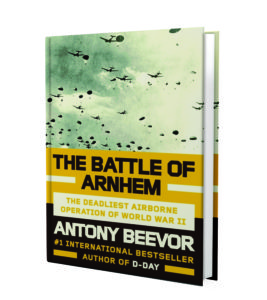
OPERATION MARKET GARDEN was a badly conceived gamble, a contest with no margin for error yet with little chance of success, and the product of misconceptions and poor planning. In September 1944, after absorbing monumental defeats in Normandy and the South of France, Germany seemed on the verge of collapse. Field Marshal Bernard Montgomery, commander of the British Twenty-First Army Group, came to believe that an airborne-armor operation—dubbed Market Garden—designed to seize a series of key bridges behind enemy lines in Holland and over the Rhine into northern Germany, would hasten the demise of Adolf Hitler’s regime. The operation would also, not coincidentally, afford logistical and command priority to Montgomery’s forces, at the expense of American-dominated armies under lieutenant generals Omar Bradley and Jacob Devers.
The result of Montgomery’s uncharacteristically bold gambit was a disaster—the destruction of the British 1st Airborne Division in the Arnhem area; heavy casualties for the U.S. 82nd and 101st Airborne divisions as they fought hard just to carve out and maintain a shaky corridor along the road they came to call “Hell’s Highway”; tremendous war damage in the numerous Dutch towns and cities where the fighting raged, plus the deaths of many Dutch resistance fighters; and a winter of grinding hunger and privation for the majority of Holland that remained unhappily under German control. Perhaps the worst strategic consequence of Market Garden was that it absorbed re-sources and attention that, given Allied supply difficulties, would have been better earmarked to clear the Germans from Belgium’s Scheldt estuary and thus give the Allies access to the magnificent port facilities of Antwerp.
Well-known British historian Antony Beevor thoroughly chronicles this tragic yet epic story. A writer of consummate skill with an ability to access a rich blend of source material in multiple languages, Beevor brings to life the human tale from the perspective of all the battle’s participants. Dutch resistance fighters; civilians; SS troopers; German army soldiers; British, American, and Polish paratroopers; and the key command personalities from both sides populate the pages seemingly in equal measure. The result is a fascinating book in which Beevor succeeds in making an otherwise familiar yarn fresh again.
In this sense, the title sells the book short. Beevor covers much more than just Arnhem. Indeed, one could argue that this fine volume is the most comprehensive ever written about Market Garden, particularly its aftermath and profound consequences for Holland.
Beevor clearly is no fan of Montgomery, whom the author takes to task for the debacle. Another target of his opprobrium is Lieutenant General Frederick “Boy” Browning, British commander of the I Airborne Corps, and an ineffective dilettante who proved himself ill-suited to lead such a complex operation. While these two men deserve plenty of blame, Beevor is too easy on General Dwight D. Eisenhower, the U.S. supreme commander who did, after all, authorize Market Garden, much to his later and admitted chagrin. Regardless, this book is the best I have read on the topic since journalist Cornelius Ryan’s brilliant A Bridge Too Far. —John C. McManus is a Curators’ Distinguished Professor of U.S. Military History at Missouri University of Science and Technology, a member of World War II’s editorial advisory board, and the author of September Hope: The American Side of a Bridge Too Far (2012).





